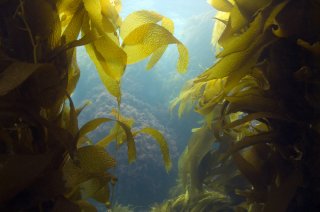
Interview
Seaweed underneath the wind turbines
Wind farm waters are unsuitable for fishing, shipping or recreation. Yet these areas may have other interesting uses, say researchers. Seaweed cultivation is one example. How does this work, and what are the challenges?
“Seaweed can play a role in our food supply, for example as a dietary supplement or in meat substitutes”, says Reinier Nauta of Wageningen Marine Research. “It also contains high-value nutrients that can be useful in animal feed or as fertiliser.”
Test locations
It sounds ideal, but there are significant challenges. “Seaweed is sown in the fall and harvested in the spring”, says Nauta. “This means that the crop is out there in the storm season, when the sea is at its roughest. This is technically challenging: the currents put a lot of pressure on the system. It’s very vulnerable. There is certainly room for improvement.”
In addition, there are concerns about the impact of seaweed cultivation on the environment. To investigate all of these issues, Wageningen Marine Research is collaborating with other Wageningen institutes, such as Wageningen Plant Research. Together they study seaweed cultivation in test locations along the North Sea coast. There are no test locations in Dutch wind farms yet; in Belgium, there are some on a small scale.
How does seaweed cultivation affect the amount of plankton in the sea, and in turn the rest of the food chain?
“At the test locations, buoys are anchored to the seabed”, says Nauta. “These are interconnected with cables, which in turn can be connected by lines or nets.” The lines or nets are treated with a glue containing the ‘seeds’ of the seaweed. These will grow into large blades of Sugar kelp, which can reach lengths up to one and a half meters in length.
In perspective
While growing, seaweeds absorb nitrogen and phosphate from the water. “The rest of the ecosystem also depends on these nutrients”, says Nauta. “In other words, there is competition. How does this affect the amount of plankton in the sea, and in turn the rest of the food chain?”
According to initial estimates, around 150 square kilometers could be allocated to seaweed farming without putting too much strain on the ecosystem. “This would fit easily into the area allotted for future wind farms”, says Nauta. “This should be seen in perspective, though. Look at our entire agricultural area. More than 50 percent of the surface of the Netherlands, including inland waters and IJsselmeer but excluding the Dutch North Sea, is used for agricultural purposes. This equates to more than 22 thousand square kilometers.”
Complex ecosystem
At Nauta’s request, research institute Deltares made a model calculation to determine the impact of seaweed cultivation on phytoplankton. “This impact turned out to be limited”, says Nauta, “but it does extend many kilometers downstream. This is what we had expected, but it had not been quantified before.”
How does this impact on phytoplankton translate into the rest of the food chain, for example in flatfish and shrimp? “That is more difficult to calculate, because of the complexity of the ecosystem. External impacts also play a role”, Nauta replies. “We will use a combination of models and experiments to further investigate the ecological impact. We’d like to find out to what extent practice corresponds with theory.”
In terms of volume, seaweed farming will not become a mega industry in our country anytime soon
Economically interesting
Nauta and colleagues are also working on increasing the seaweed yield, an important topic for the economic viability of seaweed farming. “Which orientatien of those lines will result in the greatest yield?”, he names as an example. “And can yield be increased through classical plant breeding techniques? The latter raises ethical and ecological questions, which society must address.”
Will seaweed cultivation in the Netherlands ever be a substantial economic activity? “In terms of volume, seaweed farming will not become a mega industry in our country anytime soon”, predicts Nauta. “Just look at our total agricultural area. This 150 square kilometers is really peanuts compared to that.” Nevertheless, seaweed may become economically interesting in relation to its high-value nutrients.
“And I think the demand for European seaweed will increase as consumers become increasingly critical of Asian seaweed. In addition to the fact that we have cleaner waters, which contributes to quality, more and more people are interested in buying locally-grown foods.”